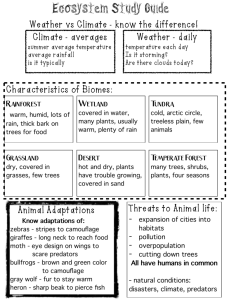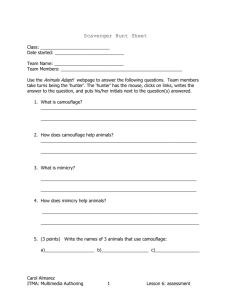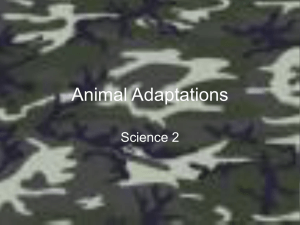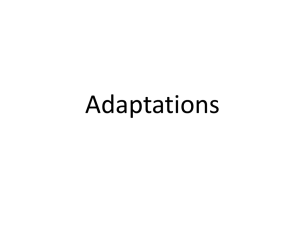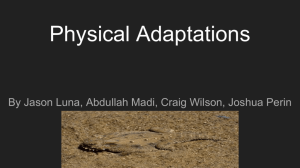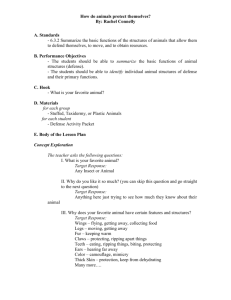Unit Plan - Rampages
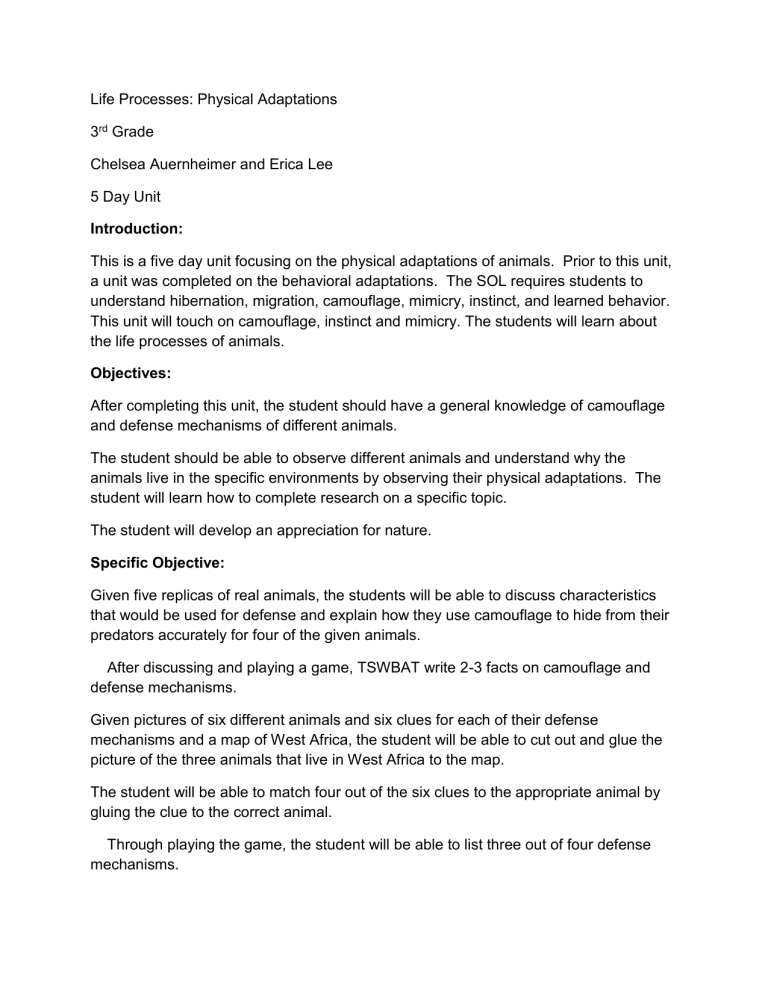
Life Processes: Physical Adaptations
3 rd Grade
Chelsea Auernheimer and Erica Lee
5 Day Unit
Introduction:
This is a five day unit focusing on the physical adaptations of animals. Prior to this unit, a unit was completed on the behavioral adaptations. The SOL requires students to understand hibernation, migration, camouflage, mimicry, instinct, and learned behavior.
This unit will touch on camouflage, instinct and mimicry. The students will learn about the life processes of animals.
Objectives:
After completing this unit, the student should have a general knowledge of camouflage and defense mechanisms of different animals.
The student should be able to observe different animals and understand why the animals live in the specific environments by observing their physical adaptations. The student will learn how to complete research on a specific topic.
The student will develop an appreciation for nature.
Specific Objective:
Given five replicas of real animals, the students will be able to discuss characteristics that would be used for defense and explain how they use camouflage to hide from their predators accurately for four of the given animals.
After discussing and playing a game, TSWBAT write 2-3 facts on camouflage and defense mechanisms.
Given pictures of six different animals and six clues for each of their defense mechanisms and a map of West Africa, the student will be able to cut out and glue the picture of the three animals that live in West Africa to the map.
The student will be able to match four out of the six clues to the appropriate animal by gluing the clue to the correct animal.
Through playing the game, the student will be able to list three out of four defense mechanisms.
With the help of dice and rubber placements, students will be able to physically act out defense mechanism and be able to discuss them.
Provided with a given animal, the student will research information on the animal’s camouflage and defense mechanisms and be able to list at least 1 camouflage and 3 defense mechanisms.
With access to a computer, the student will conduct research on a given animal and cite a minimum of three different sources used.
Given different art supplies (pipe cleaners, tissue paper, construction paper, markers, crayons, etc.), the student will create a pattern.
After creating a pattern/covering of an animal, the student will be able to write about it by describing where this animal would be located, how this pattern/covering will be camouflaged in this environment and how this pattern/covering is used in defense if applicable.
SOLs:
Science
3.4 The student will investigate and understand that adaptations allow animals to satisfy life needs and respond to the environment. Key concepts include a) behavioral adaptations; and b) physical adaptations.
Geography
3.4 The student will develop map skills by a) locating Greece, Rome, and West Africa; b) describing the physical and human characteristics of Greece, Rome, and West
Africa; c) explaining how the people of Greece, Rome, and West Africa adapted to and/or changed their environment to meet their needs.
Movement
3.2 The student will apply movement principles in increasingly complex movement activities.
a) Apply the concept of relationships while moving in space and using non-locomotor and manipulative skills.
b) Apply the principles of relationships when working with a partner while moving (e.g., passing a ball in front of a moving partner).
Computer Technology
C/T 3-5.7
Draw conclusions from research and relate these findings to real-world situations.
A. Use research to support written and oral presentations.
• Apply research derived from digital resources to original work.
• Demonstrate how to cite digital resources when developing nonfiction reports and presentations.
B. Apply knowledge when conducting research to develop accurate and balanced reports.
• Use best practice guidelines for evaluating research results.
Language Arts
3.11 The student will write a short report.
a) Construct questions about the topic.
b) Identify appropriate resources.
c) Collect and organize information about the topic into a short report.
d) Understand the difference between plagiarism and using own words.
Fine Arts
3.2 The student will use various art processes and techniques to produce works of art that demonstrate craftsmanship.
